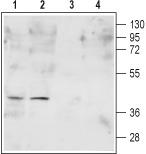FPRL1 (FPR2) Rabbit Polyclonal Antibody
Frequently bought together (2)
Transient overexpression lysate of formyl peptide receptor 2 (FPR2), transcript variant 1
USD 436.00
beta Actin Mouse Monoclonal Antibody, Clone OTI1, Loading Control
USD 200.00
Other products for "FPRL1"
Specifications
| Product Data | |
| Applications | FC, WB |
| Recommended Dilution | WB: 1:200-1:2000; IHC: 1:100-1:3,000; FC: 1:50-1:600 |
| Reactivities | Human, Mouse |
| Host | Rabbit |
| Clonality | Polyclonal |
| Immunogen | Peptide (C)GGTPEERLKVAIT, corresponding to amino acid residues 184-196 of human FPR2/ALX . 2nd extracellular loop. |
| Formulation | Lyophilized. Concentration before lyophilization ~0.8mg/ml (lot dependent, please refer to CoA along with shipment for actual concentration). Buffer before lyophilization: phosphate buffered saline (PBS), pH 7.4, 1% BSA, 0.05% NaN3. |
| Reconstitution Method | Add 50 ul double distilled water (DDW) to the lyophilized powder. |
| Purification | Affinity purified on immobilized antigen. |
| Conjugation | Unconjugated |
| Storage | Store at -20°C as received. |
| Stability | Stable for 12 months from date of receipt. |
| Gene Name | formyl peptide receptor 2 |
| Database Link | |
| Background | Chemotactic factors from both Gram-positive and Gram-negative bacteria are short peptides with N-formyl methionine at the N-terminus (extensively reviewed in reference 1). These peptides are released from bacteria during infection and activate formyl peptide receptor (FPR), a member of G-protein coupled receptors (GPCRs). In human, the FPR family consists mainly of three receptors, FPR1, FPR2/ALX (formerly FPRL1), and FPR3 (formerly FPRL2) which all couple to the Gi subtype of G-proteins and ultimately lead to the activation of phospholipase C and intracellular Ca2+ increase. FPRL1 or FPR2/ALX as commonly called is a seven transmembrane protein like all GPCRs. This receptor was originally cloned by screening a HL60 neutrophil cDNA library with a FPR1 cDNA probe. FPR2/ALX shares 69% identity with FPR1 and despite its high homology, it displays relatively low affinity for fmlf, the most potent N-formyl peptide released by bacteria. FPR1 was originally found in neutrophils and later found to be distributed myeloid and non-myeloid cells as is the case for FPR2/ALX and FPR3 (FPR3 though is not expressed in neutrophils). FPR1 is also expressed in multiple organs and tissues including epithelial cells in organs with secretory functions, endocrine cells, liver hepathocytes, smooth muscle cells and endothelial cells, brain spinal cord and both motor and sensory neurons. FPR2/ALX has a similar tissue distribution to that of FPR1. While N-formyl peptides were the first peptides found to activate these receptors, the ligand diversity for FPR has proven to be quite broad and demonstrates to be both pro- and anti-inflammatory. They include peptidic ligands originating from bacterial and viral sources (including HIV), endogenous ligands such as chemokines and annexins, short peptides associated with inflammation and infection. Interestingly, b-amyloid peptide, a known marker for Alzheimer’s disease activates FPR2/ALX thereby directly linking these receptors to the neurodegenerative disease. Lipoxin A4 (LXA4) is the first identified endogenous ligand for FPR2/ALX and is an eicosanoid with potent anti-inflammatory characteristics. Considering that FPR2/ALX can be activated by two different types of ligands, this receptor can be categorized in two different GPCR subgroups: Formylpeptide Receptors and Leukotriene Receptors. |
| Synonyms | ALXR; FMLP-R-II; FMLPX; FPR2A; FPRH1; FPRH2; FPRL1; HM63; LXA4R |
| Reference Data | |
| Protein Families | Druggable Genome, GPCR, Transmembrane |
| Protein Pathways | Neuroactive ligand-receptor interaction |
Documents
| Product Manuals |
| FAQs |
| SDS |
{0} Product Review(s)
0 Product Review(s)
Submit review
Be the first one to submit a review
Product Citations
*Delivery time may vary from web posted schedule. Occasional delays may occur due to unforeseen
complexities in the preparation of your product. International customers may expect an additional 1-2 weeks
in shipping.






























































































































































































































































 Germany
Germany
 Japan
Japan
 United Kingdom
United Kingdom
 China
China




